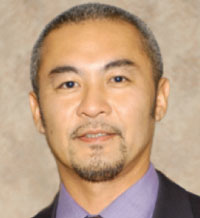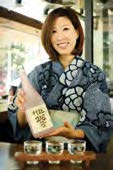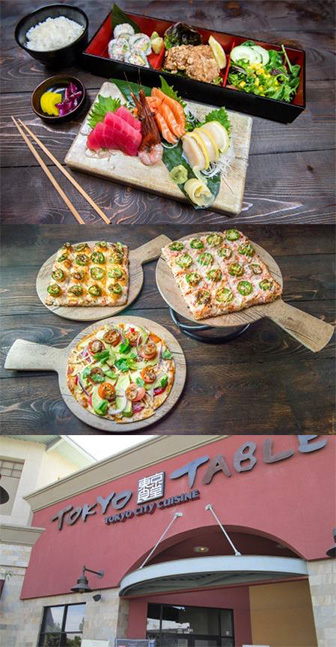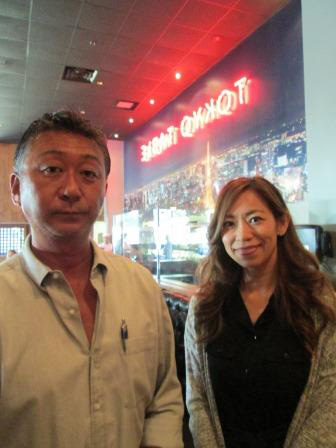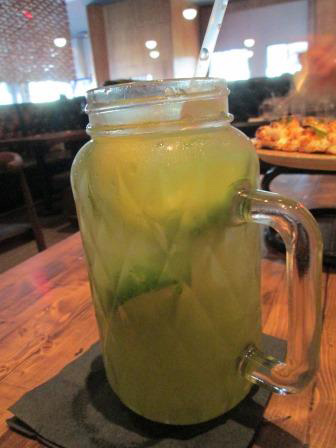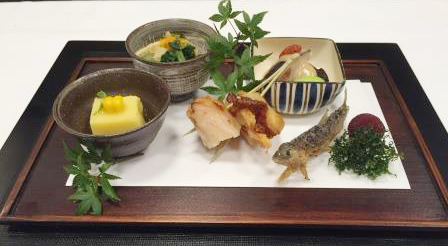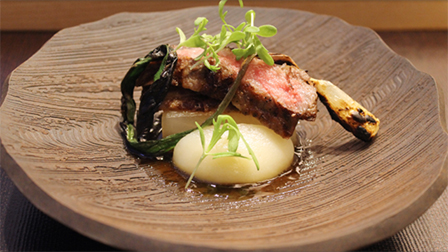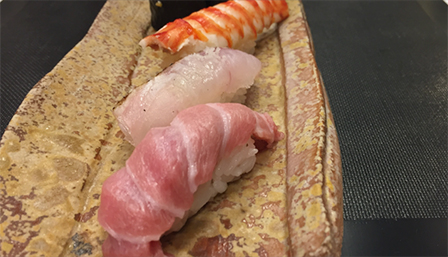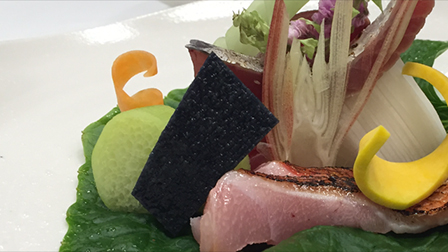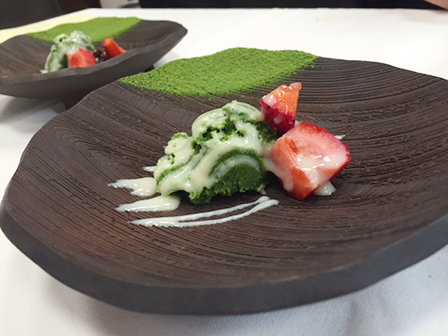By Elli Sekine
In the May, an anticipated and well talked-about true authentic Japanese restaurant called “Hashiri” opened in downtown San Francisco. Mr. Ikuo Hayashi, the CEO of an IT enterprise, “Digital Garage, Inc.”, and also the owner of “Hashiri” of Daikanyama, Tokyo, had an idea of having a first-rated authentic Japanese restaurant in San Francisco which could become the center location of his business expansion, and started this joint venture with Mr.Ryuichi Terayama and Mr. Yasuyuki Rokuyata. The menu displays only omakase-style courses of kaiseki and sushi prepared with unified Japanese and Californian ingredients. The average food cost per customer is $450, which is as high-end as other Michelin 3-star San Francisco restaurants. This “Hashiri” in S.F. is their first overseas restaurant with a new concept where the owners’ careers have been reflected, and demonstrated everywhere.
The first thing that draws your attention is its innovative appearance. The modern CA/Japan cross-cultural art by LA resident modernism designer, Yutaka Tamura, sweeps away everybody’s image of Japanese restaurants. Abstract modern art on the walls create a metropolitan pop culture-like ambience, and as a good contrast, the sushi bar is decorated with very quiet and Japan-like designs. The Japanese calligraphic letters that spell “Hashiri” are lighted up to create an impressive image. Projected on the ceiling of the dining room area are 4 seasons of Japanese scenery created by Hiroyuki Nakano, a Japanese film writer, on a very high-tech looking projector screen which gives you the feel of every season at the table.
Every department, from the reception to the kitchen, consists of a strong team of professionals who are well experienced in working for Japanese restaurants both in Japan and the U.S. The executive chef is Mr. Takashi Saito who used to be the head chef of “Yunoki”, the kaiseki chef is Mr. Shinichi Aoki who used to be the head chef of “Keigetsu” (no longer in business), and the sushi chef at the counter is Mr. Tokunori Makari from “Hashiri” Daikanyama.
“Hashiri”’s theme is the presentation of seasonal freshness. Each dish expresses the first crops, in-season produce, and ending-season produce of each seasonal period. Mr. Saito wants the customers to taste the season with all 5 senses because season is the secret ingredient of the traditional Japanese cuisine.
Californian produce must be organic, and he visits the local farmer’s market to acquire it directly from the farmers. The fresh fish is sent directly from Tsukiji by air. The omakase course created by the soul of the chef is prepared with the fresh crops of the season (hashiri) of both Japan and California, each artistically arranged in beautiful Japanese pottery imported from various regions of Japan.
The course with 12 dishes starts with the appetizer of Japanese mustard spinach which is the hashiri of spring or summer, steamed shrimp dumpling in a starchy sauce, young sweetfish karaage, etc. which are artfully arranged on a plate. The soup dish called “oan” is pike congera sea eel in broth lightly flavored with yuzu. The next is “otsukuri” (sashimi) accentuated by lotus stem and myoga ginger followed by “hachi no mono” (in a bowl) which contains eggplant topped with elegant sea urchin, then, nenrin daikon (steamed ground meat and daikon layered roll), and well-seasoned jellied meat and vegetable dish. The main dish is top-grade Kagoshima wagyu grilled on Bincho charcoal, and black-throat sea perch. The generous portion of side vegetables are also very tastefully seasoned. After that are the three sushi plates soulfully prepared by chef Makari. It takes 3 hours to finish the course all the way to the dessert, but it is a very relaxed and very worthy time spent.
The manager, Kenichiro Matsuura offers first-class service with his rich experience working in various high-end Japanese restaurants, and his language skill. The spirit of hospitality can be felt everywhere, in welcoming of the customers, immaculately clean appearance, service at the table, etc., all the way to seeing off the customers to make every customer feel special.
The drink menu is the hot target for the restaurant. In order to accommodate businessmen who like Japanese food and local foodies as well, their attractive menu includes California wines, close to 200 kinds of French wines carefully selected by the sommelier, as well as sake, shochu, spirits, Japanese whiskey, beer, etc. The restaurant is located in the middle of downtown, but despite of such a location, the area is also for the local residents to come and relax with the surrounding trees and installed benches. In order to connect with the community, and take advantage of such a location, they started to run an outdoor drink garden lounge where people can drop by for a drink after work or a convention.
You can make a reservation for three different courses; Hashiri "Omakase" at Table ($250), Hashiri "Omakase" at Sushi Bar ($300), and Hashiri " Omakase" at Chef's Table ($500) (The reservation has to be made at least 2 weeks in advance.) The private dining for up to 8 people can be reserved, and you can request for sushi-making right at the table. “Hashiri” is the one and only high-end Japanese restaurant in San Francisco, where you can enjoy beautiful traditional seasonal Japanese course meals with all of your 5 senses.
一流の食事とおもてなしを提供する高級店がオープン
5月中旬、サンフランシスコ ダウンタウンに、予々前評判で噂になっていた本格的和食レストラン、「Hashiri」がオープンした。IT 企業「デジタルガラージ」の代表取締役社長で代官山の寿司店「はしり」のオーナーである、林 都 氏がビジネス拠点となるサンフランシスコに「日本の「はしり」のコンセプトをそのままSFに」と考案し、寺山隆一氏、六彌太 恭行氏との共同経営で始動した。メニューの特徴は、日本とカリフォルニアの食材を融合させた会席と寿司のおまかせコース。客単価は一人平均$450とサンフランシスコのミシュラン三ツ星店と並ぶ高級店だ。今回海外初店舗となる「Hashiri」は、経営者達のキャリアを活かした斬新なアイディアが随所に見られる。
まず注目されるのは、洗練されたインテリアデザイン。ニューヨーク在住“モダニズム”デザイナー、滝浦 浩氏が手がけたカリフォルニアと日本の”クロスカルチャー”をイメージしたモダンアートは今までの和食レストランのイメージを一世風靡する内容。壁には抽象近代美術や肖像写真が都会的でポップなイメージを創り、一方メインの寿司カウンターは、静粛で和風。毛筆で書かれた「はしり」の文字がライトアップされ聡明な印象だ。また、ダイニングの天井には、日本の映像作家、中野裕之氏による美しい日本の四季折々の風景がハイテク技術を搭載したプロジェクターパネルに映し出され、テーブルに居ながら「季節」を感じることができる。
スタッフは、レセプションから厨房に至るまで現地と日本で和食レストランに精通してきた強力なチームが結成されている。エグゼキュティブシェフには「柚木」の料理長を務めていた斎藤隆嗣氏、会席シェフには「keigetsu」(現在は閉店)で料理長を務めた青木紳一氏、そして寿司シェフには、代官山の「はしり」から銘苅徳則氏がカウンターに立つ。
「Hashiri」のテーマは季節の旬を創作する事。それぞれの季節の「はしり」(季節に初めて出回るもの)、「旬」(出盛りのもの)、「なごり」(そろそろ終わりだなという時期)への繋がりが一つ一つの器に表現されている。「日本の伝統料理の極意である季節を五感で味わってほしい」と 斎藤氏は、カリフォルニア食材はオーガニックにこだわり、仕入先も地元のファーマーズマーケットに出向き農家から直接調達している。良質で新鮮な魚は築地からの空輸。まさに日本とカリフォルニア食材が融合したおまかせ料理は、日本各地から取り寄せた美しい陶器に、シェフの職人魂が込められた「はしり」独特の季節の料理が盛られる。
12品のコースの内容は、春、夏のはしりである小松菜、豆腐、海老しんじょう、稚鮎の唐揚げなどがアートのように盛られた前菜から始まる。「おわん」は、はしり牡丹鱧が優しい旬のブロスと柚子がほのかに香る一品。蓮の茎やミョウガを添えた「お造り」に続き「鉢のもの」は、翡翠茄子の上にバフン雲丹をあしらい、年輪大根、風味を閉じ込めたうまだしゼリーのお膳。メインの焼き物には、Aグレード, 鹿児島和牛の備長炭焼、ノドグロ、それを取り巻く旬の野菜も絶妙な炊き加減でボリュームはあるが上品な味付けだ。その後、銘苅氏が腕を奮う握りが3コース続く。デザートまで約3時間を要するディナーだが、ゆったりとした上質な時が流れる。
マネージャーの 松浦顕一郎氏は、これまで各高級和食レストランに勤めた経験と語学力を活かし一流のサービスを手がけている。店の清掃、予約客の“お迎え”から接客、“お見送り”に至るまでで、“おもてなし”の精神は、店全体に行き渡り訪れる客を特別な気持ちにさせている。
ドリンクメニューは、同店のターゲットである、日本食通のビジネスマンやフーディーな地元客に対応すべく、日本酒、焼酎、スピリッツ、日本ウィスキー、ビールの他、ソムリエによるワインリストは、カリフォルニア、バーガンディー、フランス産の厳選ブランド約200種類が並ぶ魅力的なメニューだ。また、同店舗はダウンタウンの中心にありながら、緑とベンチを配置した市民の憩いの場に位置するため、コミュニティーと接続するテラスを外に設置し、会社帰りやコンベンションの人達が“イッパイ”やれる「ドリンクガーデンラウンジ」を始めた。
予約は一般テーブル$250、寿司バー$300、特別シェフテーブル$500(2週間前までの予約要)がある。プライベートダイニングは8人までが利用でき、テーブル前ですしを握るサービスもある。「Hashiri」は、サンフランシスコで日本伝統の美しい季節のコース料理を五感で楽しめる随一の高級和食店だ。
Hashiri
4 Mint Plaza
San Francisco, CA 94103
415-908-1919
http://hashirisf.com/
first seating begins at 5:00 pm and second seating time starts at 8:00 pm.

